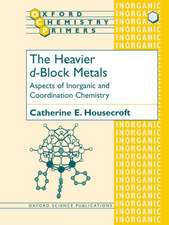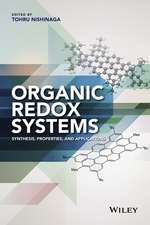Principles of Organometallic Chemistry
Autor G. E. Coatesen Limba Engleză Paperback – oct 1968
Preț: 379.75 lei
Nou
Puncte Express: 570
Preț estimativ în valută:
72.70€ • 74.77$ • 60.31£
72.70€ • 74.77$ • 60.31£
Carte tipărită la comandă
Livrare economică 19 februarie-05 martie
Preluare comenzi: 021 569.72.76
Specificații
ISBN-13: 9780412153501
ISBN-10: 0412153505
Pagini: 258
Ilustrații: XII, 258 p.
Dimensiuni: 152 x 229 x 15 mm
Greutate: 0.37 kg
Ediția:Softcover reprint of the original 1st ed. 1968
Editura: SPRINGER NETHERLANDS
Colecția Springer
Locul publicării:Dordrecht, Netherlands
ISBN-10: 0412153505
Pagini: 258
Ilustrații: XII, 258 p.
Dimensiuni: 152 x 229 x 15 mm
Greutate: 0.37 kg
Ediția:Softcover reprint of the original 1st ed. 1968
Editura: SPRINGER NETHERLANDS
Colecția Springer
Locul publicării:Dordrecht, Netherlands
Public țintă
ResearchCuprins
1. General Survey.- Historical background.- Properties.- Classification of organometallic compounds by bond type.- Covalent, two-centre, two-electron bonds.- Ionic organometallic compounds.- Electron-deficient (multicentre bonded) compounds.- Cluster compounds.- Occurrence of bond type in organo-transition metal complexes.- Availability of electron orbitals in metals and metalloids.- The stability of organometallic compounds.- 2. Methods of Formation of Metal-Carbon Bonds of the Main Group Elements.- The reaction between a metal and an organic halogen compound.- Metal exchange:—the reaction between a metal and an organometallic compound of another metal.- Reactions of organometallic compounds with metal halides.- Insertion of olefins and acetylenes into metal-hydrogen bonds.- Formation of metal-carbon bonds by other insertion reactions.- Reactions of diazo compounds.- Decarboxylation of heavy B-metal salts.- Mercuration and thallation of aromatic compounds.- Mercuration of olefins and acetylenes.- 3. Organometallic Compounds of Elements of the First Three Periodic Groups.- Structural aspects of the metal alkyls.- Preparative aspects.- 4. Organometallic Compounds of Elements of Main Groups IV and V.- Group IVB elements.- Silicones.- Group VB elements.- 5. Organometallic Compounds of the d-Block Transition Elements: Classification of Ligands and Theories of Bonding.- Classification of ligands.- The 18-electron rule.- Bonding in organometallic ?-complexes.- The bonding of other unsaturated hydrocarbons to transition metals.- 6. Preparation of Organo-Transition Metal Compounds.- General considerations.- Preparative routes.- Substitution by organometallic derivatives of main group elements.- Substition using organometallic derivatives of the transition elements : ligandtransfer.- From complex transition metal anions and halides.- Unexpected products.- 7. Reactions and Structures of Organometallic Compounds of the Transition Elements.- One-electron ligands.- Two-electron ligands.- Three-electron ligands: ?-allyl and ?-enyl complexes.- Four electron (diene) ligands.- Five-electron (dienyl) ligands.- Six-electron ligands.- Transition metal complexes containing ?-bonded heterocyclic ligands.- Seven-electron ligands.- Cyclo-octatetraene complexes.- 8. The Organic Chemistry of Ferrocene and Related Compounds.- The aromatic character of cyclic CnHnligands in transition metal complexes.- Aromatic properties of co-ordinated ligands.- Some mechanisms of electrophilic substitution.- Some particular reactions.- The interaction of the iron atom with ring substituents: ?-carbonium ion stabilization.- 9. Organometallic Complexes Formed from Acetylenes.- Mono-acetylene complexes.- Bisacetylene mononuclear complexes.- Trisacetylene complexes.- 10. The Role of Organotransition Metal Complexes in Some Catalytic Reactions.- Olefin isomerisation.- Homogeneous hydrogenation of olefins.- The oxidation of ethylene to acetaldehyde.- The trimerization of butadiene and related reactions catalyzed by some ?-allyl metal complexes.- Hydroformylation and related carbonylation reactions.- Catalytic conversation of acetylenes to ?? unsaturated acids in the presence of nickel carbonyl (Reppe process).- Vitamin B12 chemistry and related topics.- Nitrogen fixation.




